Abstract
The dominant +1 frameshift suppressors sufA6, sufB1 and sufB2, in Salmonella typhimurium act at runs of C and affect tRNA(Pro)1, tRNA(Pro)2 and tRNA(Pro)2, respectively. A recessive +1 frameshift suppressor, sufC, has a similar suppressor specificity (Riddle, D.L., and Roth, J.R., Mol. Biol. 66, 483 and 495, 1972). We show that sufC strains harbour two frameshift suppressors of which one, sufX201, is allelic to sufB. We cloned the sufB+ wild type allele and by recombination in vivo the mutations sufB1, sufB2 and sufX201. Determination of the DNA sequence revealed that the sufB1 and sufB2 mutations result in an extra G in the anticodon loop of the minor tRNA(Pro)2. The sufX201 mutation results in a base substitution (G43 to A43) in the anticodon stem of this tRNA. Although the sufB1 and sufB2 mutations were earlier shown to be dominant, the sufB+ wild type allele on multi copy plasmid inhibited the chromosomal sufB1, sufB2 and sufX201 mediated frameshift suppression but not that mediated by the dominant sufA6 mutation. These results are discussed in view of the possible coding specificity of these mutated tRNAs. The DNA sequence showed a potential consensus promoter sequence upstream of the structural gene for tRNA(Pro)2 and downstream a dyad symmetrical structure followed by a T cluster, a possible rho-independent termination signal. The Salmonella tRNA(Pro)2 gene is identical to the Escherichia coli counterpart reported by Komine, Y. et al. (J. Mol. Biol. 212, 579-598, 1990). While the 5' flanking sequence similarity between the two species is about 83%, the similarity of the 3' flanking sequence is only 42%. Still, the Salmonella tRNA(Pro)2 gene has a rho-independent transcriptional termination signal similar to the one present in E. coli tRNA(Pro)2 gene.
Full text
PDF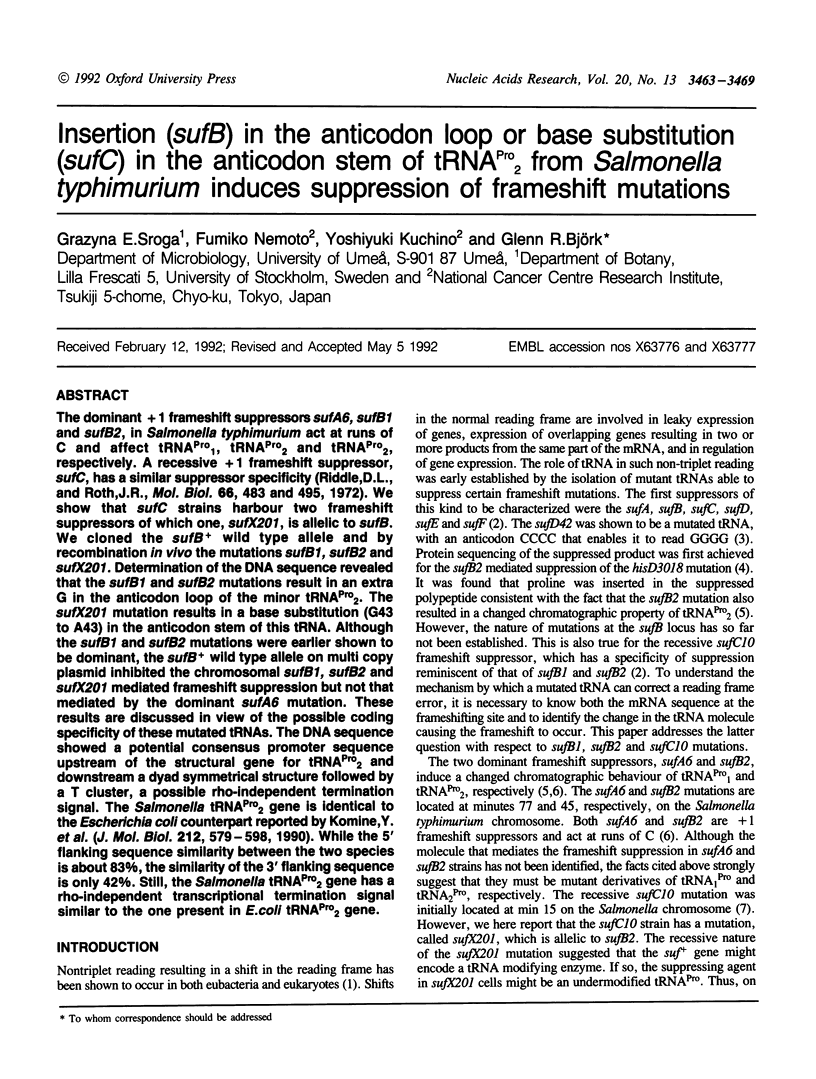
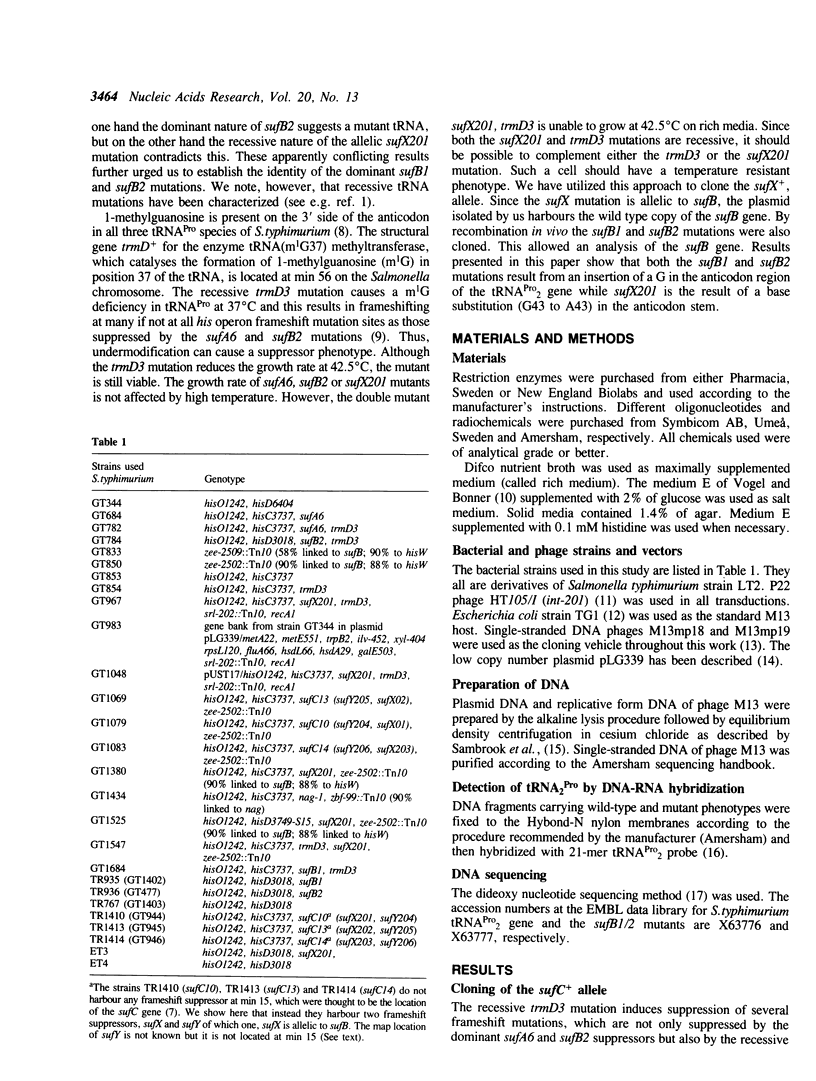
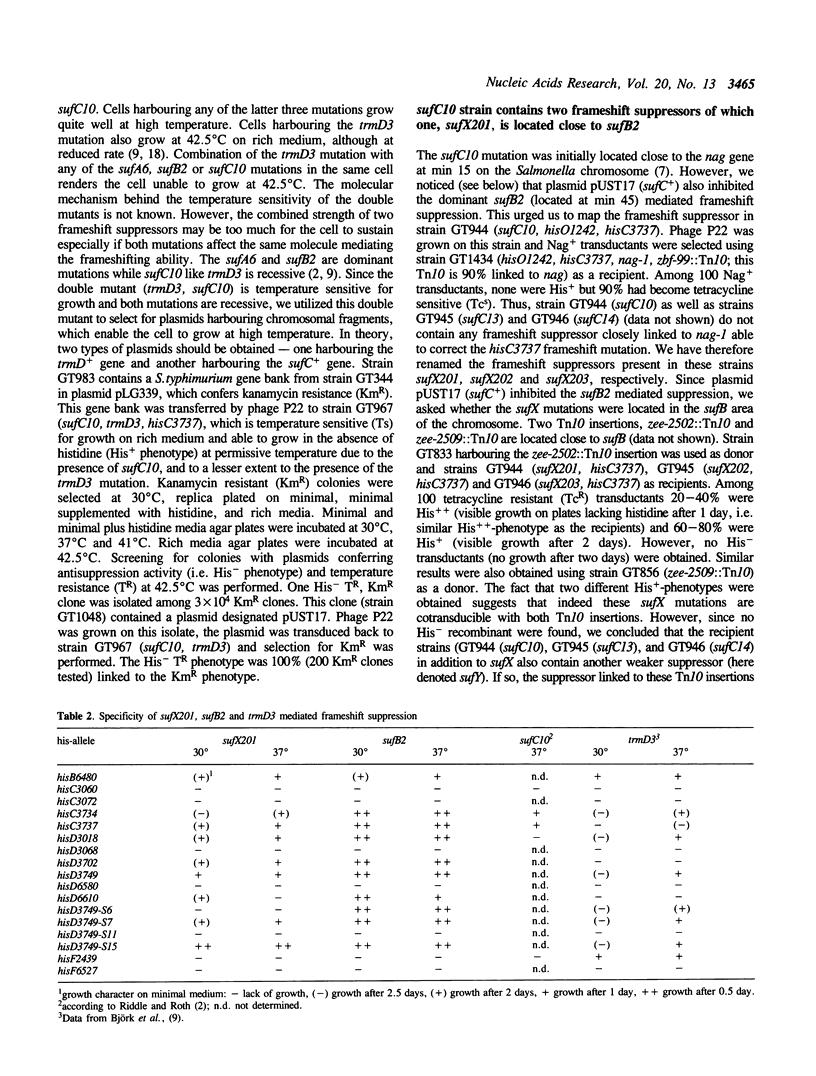
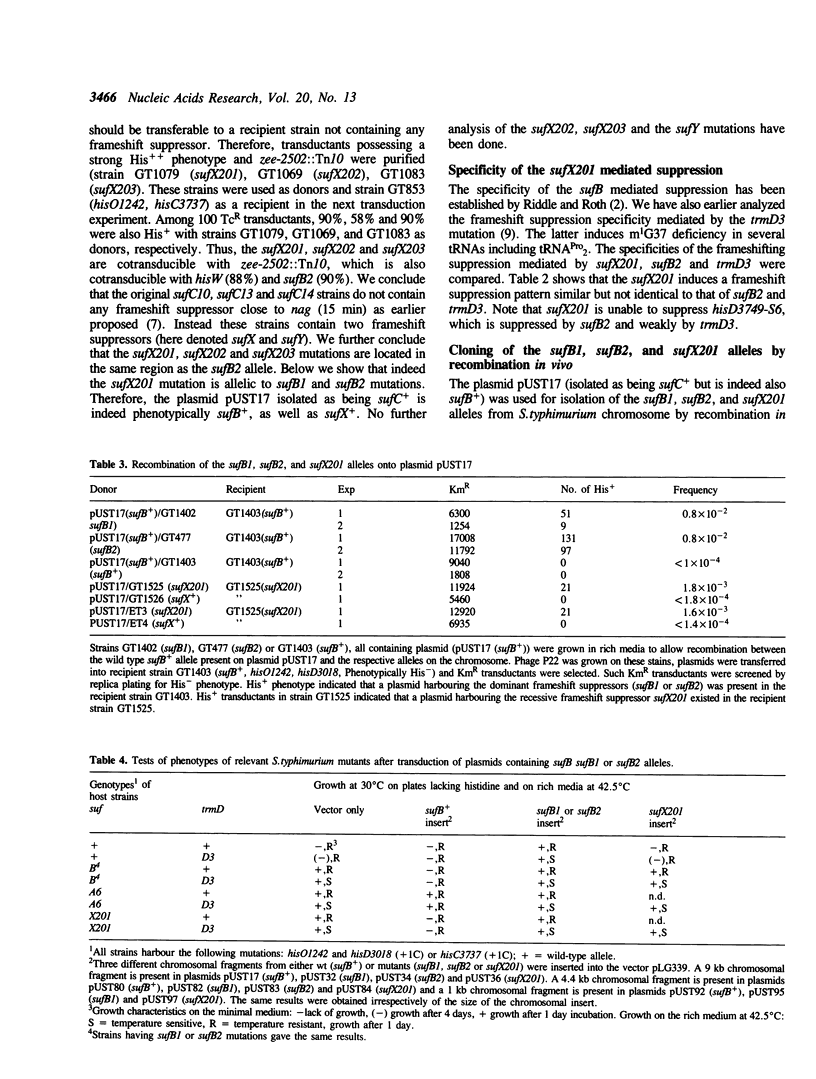
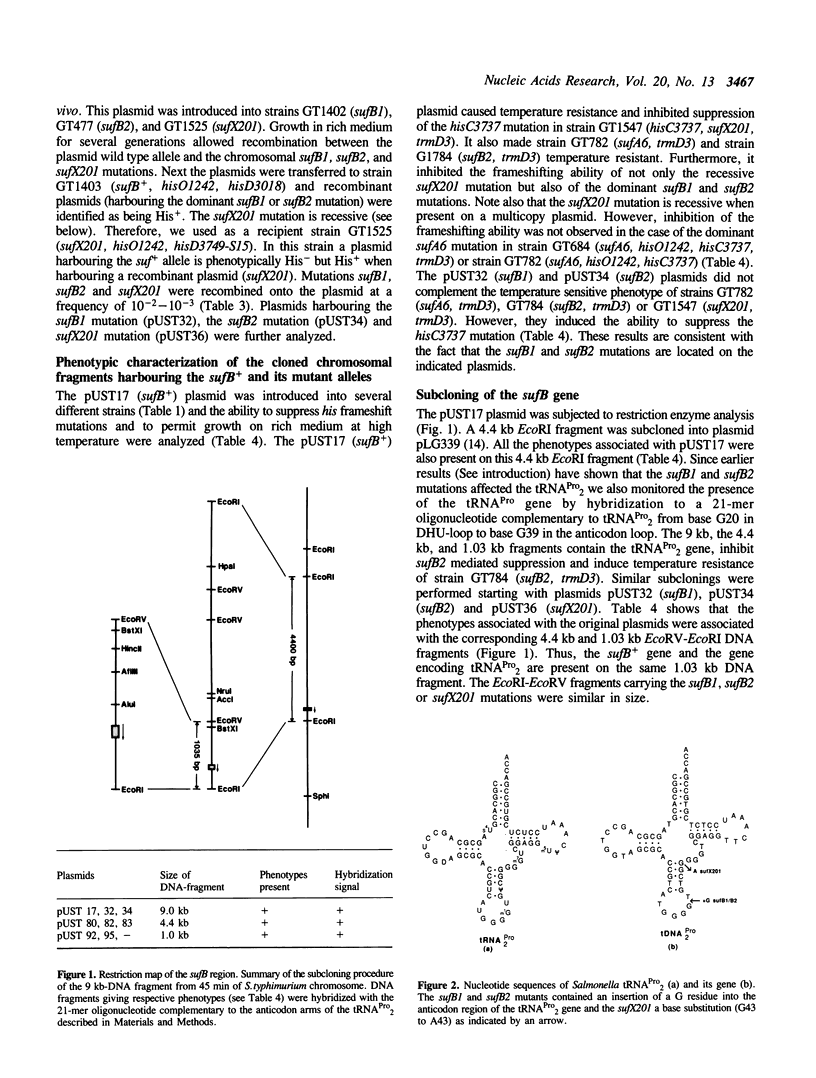
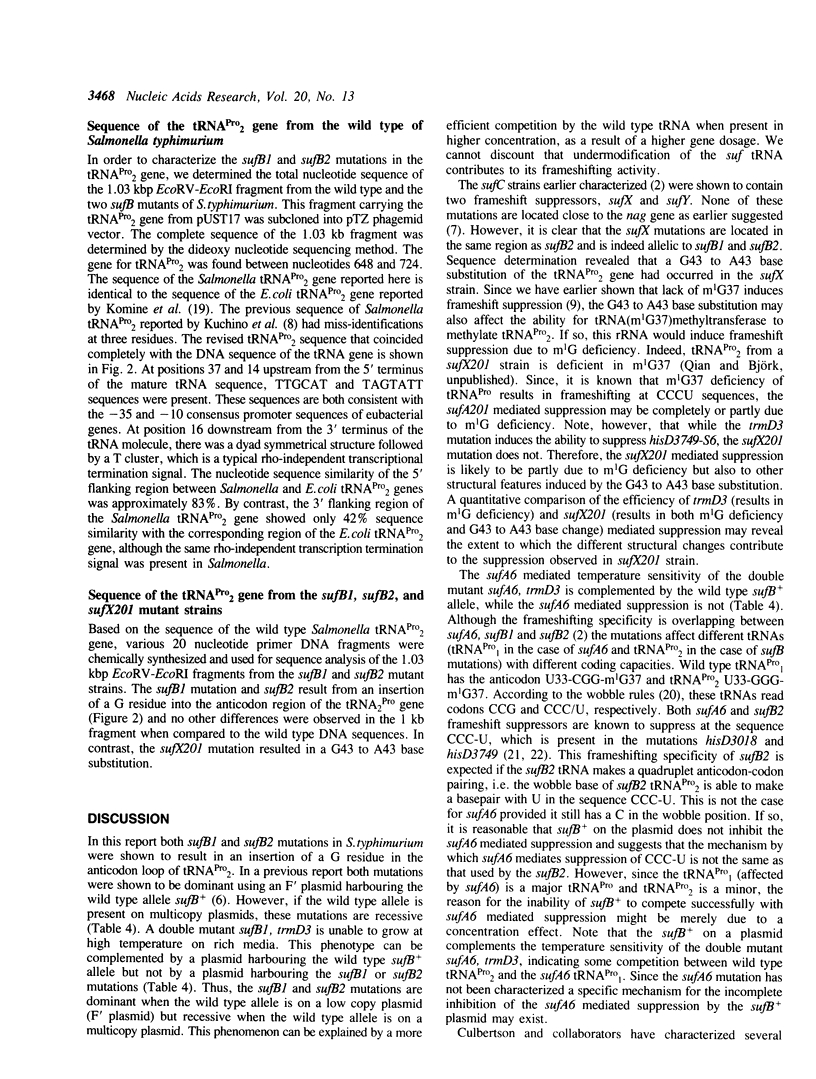
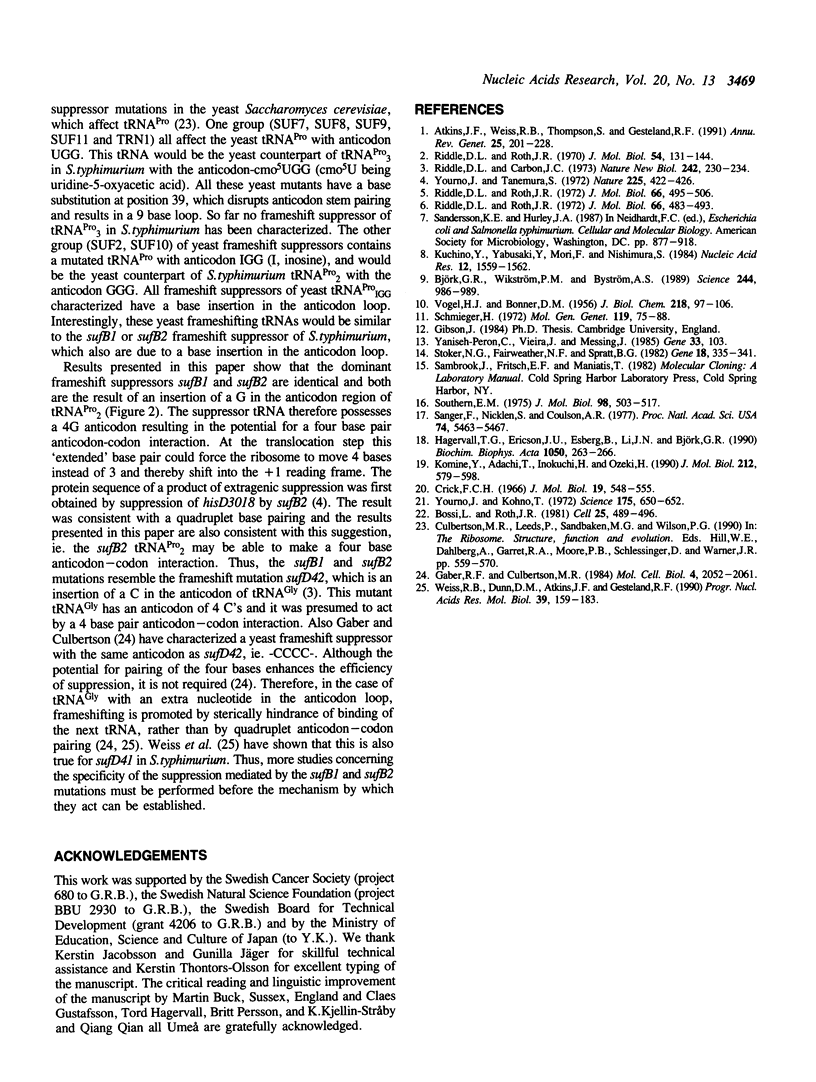
Selected References
These references are in PubMed. This may not be the complete list of references from this article.
- Atkins J. F., Weiss R. B., Thompson S., Gesteland R. F. Towards a genetic dissection of the basis of triplet decoding, and its natural subversion: programmed reading frame shifts and hops. Annu Rev Genet. 1991;25:201–228. doi: 10.1146/annurev.ge.25.120191.001221. [DOI] [PubMed] [Google Scholar]
- Björk G. R., Wikström P. M., Byström A. S. Prevention of translational frameshifting by the modified nucleoside 1-methylguanosine. Science. 1989 May 26;244(4907):986–989. doi: 10.1126/science.2471265. [DOI] [PubMed] [Google Scholar]
- Bossi L., Roth J. R. Four-base codons ACCA, ACCU and ACCC are recognized by frameshift suppressor sufJ. Cell. 1981 Aug;25(2):489–496. doi: 10.1016/0092-8674(81)90067-2. [DOI] [PubMed] [Google Scholar]
- Crick F. H. Codon--anticodon pairing: the wobble hypothesis. J Mol Biol. 1966 Aug;19(2):548–555. doi: 10.1016/s0022-2836(66)80022-0. [DOI] [PubMed] [Google Scholar]
- Gaber R. F., Culbertson M. R. Codon recognition during frameshift suppression in Saccharomyces cerevisiae. Mol Cell Biol. 1984 Oct;4(10):2052–2061. doi: 10.1128/mcb.4.10.2052. [DOI] [PMC free article] [PubMed] [Google Scholar]
- Hagervall T. G., Ericson J. U., Esberg K. B., Li J. N., Björk G. R. Role of tRNA modification in translational fidelity. Biochim Biophys Acta. 1990 Aug 27;1050(1-3):263–266. doi: 10.1016/0167-4781(90)90178-5. [DOI] [PubMed] [Google Scholar]
- Komine Y., Adachi T., Inokuchi H., Ozeki H. Genomic organization and physical mapping of the transfer RNA genes in Escherichia coli K12. J Mol Biol. 1990 Apr 20;212(4):579–598. doi: 10.1016/0022-2836(90)90224-A. [DOI] [PubMed] [Google Scholar]
- Kuchino Y., Yabusaki Y., Mori F., Nishimura S. Nucleotide sequences of three proline tRNAs from Salmonella typhimurium. Nucleic Acids Res. 1984 Feb 10;12(3):1559–1562. doi: 10.1093/nar/12.3.1559. [DOI] [PMC free article] [PubMed] [Google Scholar]
- Riddle D. L., Carbon J. Frameshift suppression: a nucleotide addition in the anticodon of a glycine transfer RNA. Nat New Biol. 1973 Apr 25;242(121):230–234. doi: 10.1038/newbio242230a0. [DOI] [PubMed] [Google Scholar]
- Riddle D. L., Roth J. R. Frameshift suppressors. 3. Effects of suppressor mutations on transfer RNA. J Mol Biol. 1972 May 28;66(3):495–506. doi: 10.1016/0022-2836(72)90429-9. [DOI] [PubMed] [Google Scholar]
- Riddle D. L., Roth J. R. Frameshift suppressors. II. Genetic mapping and dominance studies. J Mol Biol. 1972 May 28;66(3):483–493. doi: 10.1016/0022-2836(72)90428-7. [DOI] [PubMed] [Google Scholar]
- Riddle D. L., Roth J. R. Suppressors of frameshift mutations in Salmonella typhimurium. J Mol Biol. 1970 Nov 28;54(1):131–144. doi: 10.1016/0022-2836(70)90451-1. [DOI] [PubMed] [Google Scholar]
- Sanger F., Nicklen S., Coulson A. R. DNA sequencing with chain-terminating inhibitors. Proc Natl Acad Sci U S A. 1977 Dec;74(12):5463–5467. doi: 10.1073/pnas.74.12.5463. [DOI] [PMC free article] [PubMed] [Google Scholar]
- Schmieger H. Phage P22-mutants with increased or decreased transduction abilities. Mol Gen Genet. 1972;119(1):75–88. doi: 10.1007/BF00270447. [DOI] [PubMed] [Google Scholar]
- Southern E. M. Detection of specific sequences among DNA fragments separated by gel electrophoresis. J Mol Biol. 1975 Nov 5;98(3):503–517. doi: 10.1016/s0022-2836(75)80083-0. [DOI] [PubMed] [Google Scholar]
- Stoker N. G., Fairweather N. F., Spratt B. G. Versatile low-copy-number plasmid vectors for cloning in Escherichia coli. Gene. 1982 Jun;18(3):335–341. doi: 10.1016/0378-1119(82)90172-x. [DOI] [PubMed] [Google Scholar]
- VOGEL H. J., BONNER D. M. Acetylornithinase of Escherichia coli: partial purification and some properties. J Biol Chem. 1956 Jan;218(1):97–106. [PubMed] [Google Scholar]
- Weiss R. B., Dunn D. M., Atkins J. F., Gesteland R. F. Ribosomal frameshifting from -2 to +50 nucleotides. Prog Nucleic Acid Res Mol Biol. 1990;39:159–183. doi: 10.1016/s0079-6603(08)60626-1. [DOI] [PubMed] [Google Scholar]
- Yanisch-Perron C., Vieira J., Messing J. Improved M13 phage cloning vectors and host strains: nucleotide sequences of the M13mp18 and pUC19 vectors. Gene. 1985;33(1):103–119. doi: 10.1016/0378-1119(85)90120-9. [DOI] [PubMed] [Google Scholar]
- Yourno J., Kohno T. Externally suppressible proline quadruplet ccc U. Science. 1972 Feb 11;175(4022):650–652. doi: 10.1126/science.175.4022.650. [DOI] [PubMed] [Google Scholar]
- Yourno J., Tanemura S. Restoration of in-phase translation by an unlinked suppressor of a frameshift mutation in Salmonella typhimurium. Nature. 1970 Jan 31;225(5231):422–426. doi: 10.1038/225422a0. [DOI] [PubMed] [Google Scholar]


